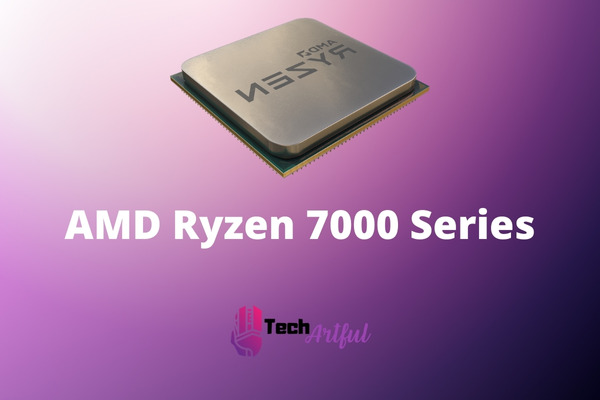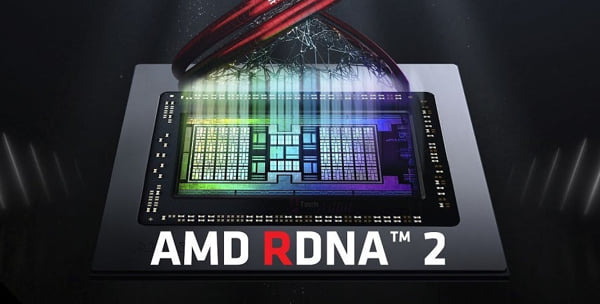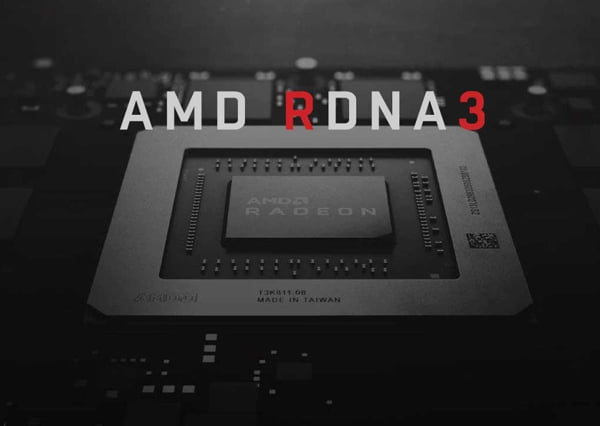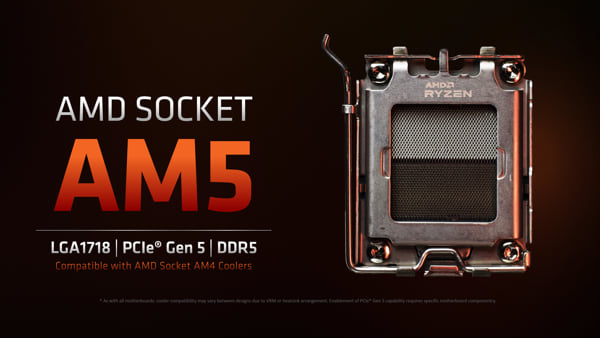AMD CEO Lisa Su made the announcement on the next Ryzen 7000 series CPUs at the Computex 2022 convention. The new chips will be the first desktop central processing units (CPUs) built on TSMC’s 5-nanometer technology and will contain up to 16 Zen 4 cores each. Additionally, they will be compatible with AMD’s latest AM5 architecture.
On top of that, Lisa Su also mentioned that the Ryzen 7000 system is able to complete different processes 31% faster! This means that creators can spend less time waiting and much more time content creating.
We now have just a limited amount of information on AMD’s Ryzen 7000 series. However, on the other hand, judging by what AMD displayed at Computex, the latest chips could be able to compete with the current 12th Generation Core CPUs that are being offered by Intel.
So, here is all we know about the forthcoming AMD Ryzen 7000 series processors, including the release date and the specs.
AMD Ryzen 7000 Release Date
It is anticipated that AMD’s Ryzen 7000 series CPUs will become available sometime around the fall of 2022. AMD has not specified any particular release date, perhaps as it is still early in the development process.
Also, The industry did not reveal how much the new chips based on the Zen 4 architecture would cost, but they did plan to provide further information over the course of the summer.
However, at the end of July 2021, Lisa Su provided confirmation that both RDNA 3 as well as Zen 4 (Ryzen 7000) will be made available in the year 2022. At the Consumer Electronics Show (CES) 2022, AMD provided a brief demonstration of the Ryzen 7000, Ryzen 6000 portable, and the Ryzen 5800X3D, which was made available to the public in April of 2022.
According to a couple of unidentified industry insiders who spoke with Digital Times, AMD is planning to launch its latest Ryzen 7000 desktop CPUs in September.
This information was previously revealed by Digital Times. Early in the month of May in 2022, AMD made public their strategies for the forthcoming Ryzen 7000 Zen 4 series of laptops.
Moreover, at Computex 2022, Lisa Su demonstrated Ryzen 7000 in-game. She also provided us with some details on the AM5 chipset and verified that the product would be released in the fall of 2022.
Consequently, the Dragon Range and Phoenix designs from AMD will be distributed throughout the entirety of the year 2023. The Dragon Range CPUs will be used in intense gaming laptops with processors that need 55W or more, while the Phoenix CPUs will be used in small and light gaming laptops. These two lineups are both built on Zen 4, which is the core of the game.
So, until the Ryzen 7000 series processor is released, we may make use of some of the Zen 3 possessors that were introduced in 2022 in the meantime.
Estimated Price of AMD Ryzen 7000
Now, the main attraction of these latest processors, what will the price of AMD Ryzen 7000 series processors be? Should we predict the price, which is identical to Ryzen 5000 series processors? In light of the fact that Intel will maintain a high level of competition for the whole of 2022, and thus, AMD will have to approach this pricing with extreme caution.
Because of this, we expect that the Ryzen 7000 series will be more affordable than the Ryzen 5000 series CPUs.
The following is a list of some estimated pricing ranges for the Ryzen 7000 series CPUs:
- Ryzen 5 7600X – $299
- Ryzen 7 7700X – $370
- Ryzen 7 7800X – $420
- Ryzen 9 7900X – $510
- Ryzen 9 7950X – $799
However, be aware of the fact that, in the event that these processors perform far better than anticipated, the cost may even end up being more costly than it was for the generation before.
AMD Ryzen 7000 Specifications
According to AMD’s announcement, the Ryzen 7000 series of processors are the first desktop CPUs to be built on a 5-nanometer manufacturing process. As per the industry, the CPUs will feature clock rates that are more than 5 GHz.
The Zen 4 CPUs will have a single-threaded performance that is “more than 15 percent” quicker than that of the Zen 3 processors. It is anticipated that each core on the chips would contain 1 megabyte (MB) of L2 cache, which will result in improved acceleration for AI-related workloads.
During CES 2022, the Ryzen naming system was riddled with a great deal of confusion, but after that event, things became a little clearer. The Ryzen 7000 desktop CPUs are built on a 5nm manufacturing node and are the ultimate response to Intel’s Alder Lake and, perhaps, Raptor Lake as well. These processors are named Zen 4 and have model number 7000.
Despite the fact that Ryzen 6000 (the missed number) will only be used for cellphone CPUs (for the time being), competing with Intel won’t be simple. When taking into consideration, how huge Intel’s latest hybrid technology is, AMD has a lot of things it has to be concerned about.
For example, Intel’s big. LITTLE, this leads to a boost in performance while also bringing about an improvement in performance. As a result, we have very high hopes for the newest CPUs available from AMD.
At Computex 2022, AMD demonstrated its 16-core powerhouse Ryzen 7000 processor by playing Ghostwire: Tokyo at a core clock speed of up to 5.5 GHz. The demonstration took place throughout the event.
Prior to this, the maximum frequency that a Ryzen CPU has ever achieved was merely 4.9 GHz (5950X), so this is unquestionably a significant step forward for AMD.
Not just the core frequency but also other aspects of the chip’s performance were highlighted by AMD. In addition to that, they claim that the single-threaded speed will improve by 15%, that the capacity of the L2 cache will double, and that enhanced operations will include AI acceleration.
We aren’t quite certain what this AI acceleration is or what it will deliver, but either way, we couldn’t be more thrilled about it. That 15 percent improvement in performance is already more than acceptable. They took our minds!
Now, let’s see what this RDNA 2 and RDNA 3 thing really is.
RDNA 2
The Ryzen 7000 series will contain a built-in power management system along with a 6nm I/O core that will integrate RDNA 2 graphics, DDR5, PCIe 5.0 controllers, and more. Also, there has never been a Ryzen CPU that has a built-in graphics solution, and that has been the case throughout all generations.
AMD supported the concept of throwing away the integrated graphics processing unit (IGPU) in order to improve the performance of the CPU. And I can say that I understood the reasoning behind it at the time. To the extent that gamers are concerned.
Because of this, an integrated graphics processing unit (IGPU) isn’t actually necessary for the majority of gamers that play on their personal computers. In addition, customers have the option of purchasing a G-type Ryzen central processing unit (CPU), which is a slower model but has an integrated graphics processing unit (IGPU). For instance, Ryzen 2400G, 4700G, 5600G, 5700G, and so on.
There’s a chance that things may turn out differently this time around. Ryzen 7000 may feature an iGPU. And not just any GPU, but rather one that was RDNA 2 compatible.
According to Komachi Ensaka, an industry insider for PC Hardware, the RDNA 2 iGPU may ship with two WGPs (Work Group Processors) running at 1.1 GHz each. To put it another way, there is a possibility that it will be helpful.
Lately, we have observed the RDNA 2 iGPUs in the mobile Ryzen 6000 work exceptionally well, surpassing the performance of Intel’s XE iGPUs by a significant margin. That ought to be seen as a favorable prediction for Zen 4
However, Komachi also believes that Ryzen 6000 mobile CPUs would contain a significantly more capable RDNA 2 graphics card, but we all know this is not confirmed.
RDNA 3
In the last section, we discussed the strength that would be available in the next generation of Ryzen CPUs thanks to RDNA 2. These integrated graphics processing units (iGPUs) have already shown a high level of effectiveness in AMD’s most recent mobile CPUs.
But, new leaks provide evidence that the Ryzen 7000 APUs (Phoenix) would be built with RDNA 3 graphics processing units (GPUs). That will be AMD’s newest series of graphics cards, which are said to be highly competitive with Nvidia’s RTX 4000 series when it comes to gaming performance.
It is quite probable that the integrated/mobile variations of the RX 7000 GPUs will be far quicker than the iGPUs that are currently available on the market when compared to their desktop counterparts, given how fast the computer GPUs will be.
There are already reports flying that leakers are spreading about how the graphics processing unit (GPU) that will be included in Zen 4 mobile SKUs will be just as fast as Nvidia’s RTX 3060M.
It is important to note that the RTX 3060M is a separate graphics processing unit that is installed into the mainboard of a laptop. The graphics processing unit (GPU) for the Zen 4 is integrated directly into the CPU chip, which results in much-reduced power consumption.
Performance Of The AMD Ryzen 7000
The Ryzen 7000 series seems to be getting back on track by loading itself with the capability for technological advancements that have happened since the Ryzen 5000 debut. This gives the impression that the Ryzen 7000 range is catching up for the lost time.
If you want to know the numbers of performance of this AMD Ryzen 7000 series processor, then you are a little bit ahead of the curve. At the time this article was written, we did not yet have first-hand benchmarks of Zen 4.
The latest CPUs will have the capability to handle PCIe 5.0, which will open the door to the possibility of better memory and graphics cards, in addition to an improvement in power delivery. Just like with DDR5, this is an update that is designed with the future in mind.
Consumer-grade PCIe 5.0 connections aren’t currently available, but if you’re looking to expand your storage capabilities, this may be an upgrade that’s worth keeping in your armory. Even the most advanced solid-state drives (SSDs) that employ the PCIe 4.0 interface are likely to be outclassed by the performance of their PCIe 5.0 counterparts.
The possibility for an improvement in performance is one thing that can be said about the next generation of AMD central processing units. Given that AMD will be moving away from the 7nm technology that was utilized for Zen 3 and migrating to the 5nm node instead, an IPC gain of about 10 to 15 percent is predicted.
At Computex 2022, AMD also revealed Smart Access Storage, which would seem to amplify Microsoft DirectStorage by further accelerating data transfers between the CPU, graphics card, and compatible SSDs. The end result is even quicker load times.
It seems that previous Ryzen processors will also support Smart Access Storage; however, in order for it to function, you may need an AMD Radeon graphics card. Ryzen 7000 CPUs will be capable of supporting Smart Access Storage, and they will do so in the future.
At the moment that this article was written, DirectStorage was not used in any videogames; however, this situation may have changed by the time that the Ryzen 7000 series was released in the fall.
Still, it’s possible that we’ll be looking at greater clock speeds, quicker memory, and maybe even more.
AMD’s New AM5 Platform: Socket LGA1718 with Three New Chipsets
R.I.P. to the AM4 socket, which has been a dependable AMD element ever since it was initially used by the Ryzen family of processors back in 2017. Because AM5 sockets are only compatible with Ryzen 7000 CPUs.
AM4 will be left in the dust by AMD’s upcoming 5nm chips, which will run on a new platform. That is not a negative development at all, taking into account the fact that AM4 has remained the standard for central processing units (CPUs) for the past five generations.
Therefore, it is time to move on from AM4 and adopt a newer, more advanced architecture that is quicker, more energy-efficient, and greater in general.
However, AMD has assured that any cooling that suits AM4 will also fit AM5. In spite of this, if you do not need a replacement cooler in order to upgrade, you will almost definitely need a new motherboard. And presumably, there will be updated chipsets that the Ryzen 7000 CPUs will require in order to access all of the capabilities that they come equipped with.
Also, please remember that the Ryzen 5800X3D is still available on the AM4 platform, which is a fantastic choice if you want to future-proof your computer system.
Switching to AM5 is the greatest conceivable move for AMD since it allows space for several technological advances, the most crucial of which being DDR5 memory.
DDR5 operates at much higher frequencies and is noticeably quicker than DDR4, which operates at lower frequencies. In addition, taking into account the fact that this is only the starting for DDR5, frequencies will most likely go even more as this revolutionary technology advances.
On the other hand, in contrast to Alder Lake, there won’t be any AM5 motherboards capable of supporting DDR4 memory.
Do you think that was a wise decision on the part of AMD? As a result of the decision, it will no longer be possible to use a Zen 4 processor in conjunction with a DDR4 RAM kit and motherboard that have a lower price tag. We are hesitant whether or not we should say goodbye to DDR4 just quite yet since DDR5 is quick and it is the technology of the future, but DDR5 has not yet reached its durability and longevity.
As of right now, we are aware of 3 motherboards that support the AM5 socket: the ultra-enthusiast X670E, the high-end X670, and the B650, which is in the middle of the spectrum. Overclocking will be possible on all three, as has been common with Ryzen, but the X670E and X670 chipsets will come equipped with a greater variety of specialized functions and settings for this reason.
The level of support for PCIe 5.0 that each chipset provides is another aspect that varies across models. On the X670E, everything is allowed, while the X670 only allows its PCIe interface to be used for solid-state drives (SSDs) and graphics cards. SSDs are the only option on B650.
AMD Ryzen 7000: Bringing Zen 4 and 5 nm
The most significant change brought about by the introduction of the 5nm Zen 4 chips is an increase in single-threaded performance that is at least 15 percent higher than that of the Zen 3-powered Ryzen 5000 processors from the previous generation.
AMD informs us that this is due to a combination of advances in instruction per cycle (IPC) and frequency, but they won’t reveal the exact proportion that each element provides until later on. AMD has said that the processors would achieve a peak frequency that is “much over” 5 GHz, and the company has even shown a 16-core device that is capable of reaching 5.5 GHz.
But, this comes with the normal condition that this frequency is solely applicable to a single core while operating under mild bursty stress. This is similar to what we’ve seen in Zen 2 and Zen 3 CPUs.
That implies that the 15 percent or more rate is not predicated exclusively on IPC gains, but higher single-thread performance does raise performance and outcome since it is enhanced when loads expand over the cores.
As a result of this, AMD increased the maximum power supply of the AM5 socket (PPT), which will host the Ryzen 7000 processors with 170W of power, which is a 28W growth over the previous-generation AM4 socket’s peak of 142W.
This will allow the Ryzen 7000 chips to run at higher clock speeds. If AMD continues to utilize their traditional formula of PPT multiplied by 1.35 times to calculate TDP, this indicates that AM5 socket processors will have a maximum TDP of 125 watts.
It seems that the Ryzen 7000 will be in competition with Intel’s Alder and Raptor Lake processors that will be far more competitive than anybody had anticipated.
Conclusion
So, this is it! That’s all we know about the upcoming AMD Ryzen 7000 processors so far. We tried our best to inform you about the release date, specifications, and estimated price range of this Ryzen 7000 series. Hopefully, reading this article has helped you know more about this processor.




